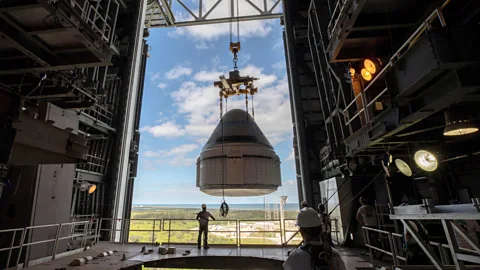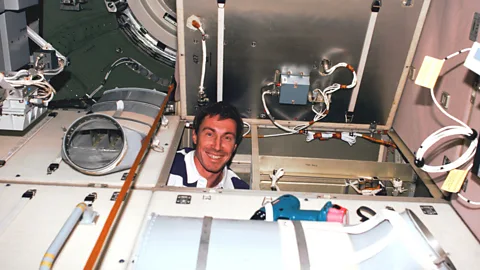What happens when astronauts get stuck in space
_o6lPd10mQE_5d1xskzegt1bekecplhtcasbmngkrguvkqmklytgzdec9ia6gqr3y0wjkkgc_x19kY91gpa_i85np8ow0gktctcfx9ppwlwug65ilgmt6y9lnsncfbikjpevhrnub8gjrv1u.png)
The two Nasa astronauts overstaying on the ISS aren't the first astronauts to be stuck in space… and they probably won't be the last.
We've all been there…stuck for hours on a broken-down train, abandoned in an airport because of a software update or – my most memorable – stranded in the Falkland Islands after an aircraft engine on an ageing air force transport plane caught fire. At least there were penguins to look at.
Spare a thought, then, for Nasa astronauts Sunita Williams and Butch Wilmore, now more than two months into their eight-day mission to the International Space Station (ISS). It is thought that the spacecraft that took them there – Boeing's shiny new Starliner – may not be capable of getting them safely back to Earth.
At a Nasa media briefing on 7 August, senior officials detailed the problems with components in the Starliner's multiple thrusters. There were leaks in its propulsion system and some thrusters powered down. Despite extensive testing on the ground, engineers have yet to understand the physics behind the issue. Meanwhile, testing in orbit shows that, in space, the thrusters are now performing well, further adding to the confusion.
Until engineers have confidence in the propulsion system, an immediate flight home for Williams and Wilmore in Starliner is looking increasingly unlikely. Although no final decision has been made, one possible scenario is to send the spacecraft back to Earth, autonomously, without them.
 Getty Images
Getty Images
The two astronauts blasted on from Earth in June and may not return before the end of the year (Credit: Getty Images)
"Our chances of an uncrewed Starliner return have increased a little bit based on the way things have gone over the last week or two," admitted Ken Bowersox, Nasa's director of space operations. "We know that at some point we need to bring Butch and Suni home."
But it may not be any time soon. If Starliner flies back empty, then Nasa plans to send up a four-seater SpaceX Crew Dragon spacecraft with just two astronauts on board. Williams and Wilmore would then remain on the station until February 2025 and return with them. With the four other Nasa astronauts on the ISS due to come back to Earth in September, that would leave the regular complement of four astronauts and three Russian cosmonauts (a total of seven) on the ISS.
"While they're up there, we have extra hands, they can do a lot more work, but they're also using up more consumables, more supplies," said Bowersox. "At some point we need to get back to a normal crew size."
There are, however, worse places to be stuck. "The space station is actually now a seven-bedroom, three-bathroom ensuite," Nasa astronaut Victor Glover, who spent six months on the ISS in 2020-21, told the Space Boffins Podcast shortly before the Starliner launch in June.
Water is plentiful and a recent resupply mission means that there is also more than enough food. And, while it might be a bit crowded inside, the view from the windows to the Earth below is truly mesmerising. Astronaut Nicole Stott once told me that whenever she looked down at the blue marble of our planet, she had to set an alarm to remind herself to get back to work.
"The astronauts are happy as clams up there," says the founder and editor of space news website SpaceUpClose, Ken Kremer, who covers launches from his base in Florida. "Many people think they're stranded, they're not."
"That's not to downplay the issues but it should never have been an eight-day mission in the first place," Kremer says. "They have both done six-month missions before and that's why they should have been assigned a longer mission."
 Alamy
Alamy
The overstay has happened because of problems with Boeing's Starliner spacecraft (Credit: Alamy)
Most of us might get angry or frustrated at a cancelled train or overnight delay in an airport but astronauts are some of the most highly trained people you will ever meet and are prepared for almost every contingency.
"We are professional risk takers," says Glover. "We do our best to mitigate those risks but going to space is not risk free."
Williams and Wilmore are two of Nasa's most experienced astronauts and mission planners have been working to make the best of the situation, integrating them into the daily schedule and using their expertise in testing Starliner. The astronauts have also helped to maintain the station, fix spacesuits, run science experiments and even took time out for some Olympic training.
The situation is not without precedent, and it could be a whole lot worse
"They're great crew members, great astronauts, great at flying Starliner," said the manager of the International Space Station programme, Dana Weigel, in a briefing earlier this month. "We've always got back up plans… they've been fully trained [for the ISS science experiments], and they're prepared for either path that we go down."
As well as conducting scientific experiments, the astronauts' familiarity with the station and its inner workings means they have been quickly deployed on household tasks, such as organising cargo, sorting food supplies and deep cleaning equipment racks. Their advanced microgravity plumbing skills have also been called upon.
Normally on the station, astronauts' sweat and urine is recycled into drinking water, but a recent fault has meant the crew have had to store urine instead, not ideal in an already cramped environment with two extra crew. With replacement parts carried with them – and additional equipment which arrived on the recent supply mission – Williams and Wilmore have been endeavouring to get the system fixed.
It says a lot about the success of the space station and the professionalism of everyone who works on the missions that dramas like this are rare. It's easy to forget that since November 2000, there have always been people living and working in space. But the situation is not without precedent, and it could be a whole lot worse.
When Soviet cosmonaut Sergei Krikalev travelled to space station Mir in May 1991, he was anticipating spending a few months in orbit. The early weeks of the mission all went to plan and included the flight of the first British astronaut, Helen Sharman. Meanwhile, down on the ground, the country Krikalev belonged to was beginning to come apart.
 Getty Images
Getty Images
Sergei Krikalev, seen here on the ISS in 1998, had to spend unscheduled extra time in space after the Soviet Union collapsed (Credit: Getty Images)
"My wife used to work in mission control, and they were worried about us and we were worried about them – a kind of mutual worry," Krikalev told me, when I met him in Moscow in 2019. "We heard about all this turbulence on the ground and all this instability and of course we were worrying about our friends, about our relatives, about our parents."
Four months later, the Soviet Union collapsed completely and although the supply ships kept being launched, there was some doubt about when Krikalev and his colleague, Aleksandr Volkov, would be able to return. The Soviet launch and landing site was now in the newly independent country of Kazakhstan, which meant the Russian government had to negotiate a deal to maintain its space programme.
Having left the Soviet Union, after almost a year in orbit, the cosmonaut eventually returned to his new home country of Russia. He would go on to become the first Russian to fly in the Space Shuttle and was among the first crew to live on the ISS.
What is clear about this latest situation is that no-one is panicking while evidence about the state of Starliner is being gathered. Nasa's final decision on whether to fly the spacecraft with or without a crew is still likely to be a few weeks away. But even if Williams and Wilmore do get to come back in September, similar situations will almost certainly arise in future – particularly as spacecraft get more sophisticated and missions go to the Moon and beyond.
Next year, Victor Glover will be piloting Artemis II, the first mission to leave Earth's orbit since 1972. "We would be doing a disservice to our profession and to the public if we made it seem like what we do is routine," Glover says. "When we fly the tenth Starliner mission, it will be just as complicated and complex."
Source: BBC

Election Roadshow

41 killed, 12 rescued after boat capsizes in NW Nigeria: official
_Tce5QlMl8J_e9eft0xea8kg8tiiszpkjr0p1pmdtsvjz97goz2mntatyqkphfyf3otizmo7_AaMVPpql80_ydvwi8zkimpcwdzsmzfbm1sx7efuwlmwplnwvpeuzqevrxiiuraklsc5c5vw.jpg)
Iran sends Chamran-1 research satellite into orbit

Jordan PM resigns after general election

Modi 3.0 prioritizes science, technology, and security with landmark ini…

Election Commission consults PM Oli on by-election at local level

'We want identity and respect as human,' cry out sexual and gender minor…






Comment